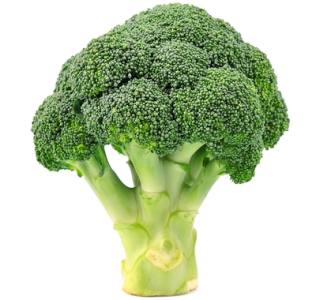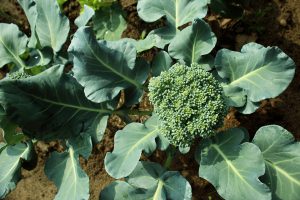Recipes we love
See all recipesBroccoli Niçois
It’s a good idea to combine several ingredients with significant nutritional benefits: broccoli (fib...
First purées with broccoli
Keep it simple: just one vegetable at a time so that the baby can get to know each flavour, very lit...
Vegetable Parmentier with carrot and broccoli
Teenagers prefer pasta and potatoes to vegetables because they find them more filling. Tempt them by...
Health
benefits
Highly concentrated nutriments
Broccoli is an extraordinary vegetable! It has an extremely high nutritional density. It is rich in vitamin C and vitamin B9, even when cooked or frozen! And that’s not all. Broccoli, like other cruciferous vegetables (cabbage, turnips, and more) contain glucosinolates, molecules that are thought to help prevent certain cancers by acting in synergy with vitamin C and beta-carotene.
Broccoli is also a source of:
- vitamin C—almost three times more raw than when cooked! (for the skin and collagen, the nervous system, psychological functions, and the immune system, and fights oxidative stress).
- vitamin B5—only when raw. (for intellectual performance and steroid hormone synthesis, fights fatigue).
- vitamin B9 (for cellular renewal, particularly important for pregnant women for fetal development, growing children, and for convalescents).
- vitamin B6—only when cooked (for the nervous system and immunity).
Broccoli also contains:
- beta-carotene (twice as much raw as when cooked!) and other carotenoids (lutein and zeaxanthin, good for eye health).
- calcium (especially when raw)
- phosphorus (raw and cooked)
- potassium (when cooked)
- magnesium (especially when raw)
Nutritional
composition
When is the right
time to eat it?
From September to April
Broccoli is a vegetable available from autumn through spring, with a season that lasts from September to April!
Vegetable patch
or urban balcony?
Broccoli is a fairly large biennial plant, whose size makes it difficult to grow in an urban setting. It grows well in cool, deep soil that is rich in clay.
To learn everything you need to know about growing broccoli, read the page on growing advice. Click here for more growing advice.
Choosing
and storing broccoli
Choose the right broccoli:
- You should pay attention to the appearance of the head, but other factors count as well. The stem should be fresh and the same color as the head, bright green, with tightly closed buds.
Properly store your broccoli:
- Broccoli lasts from four to five days when stored in the vegetable drawer of the refrigerator.
- If it wrapped in plastic, take off the packaging at the last minute. If it is not packaged, wrap it in plastic before putting it in the refrigerator. By doing so, you preserve the buds.
Tips
and tricks
How to prepare broccoli
We eat the young florets, or the little-developed groups of buds, but also the stalk.
Cook the broccoli quickly, on moderate heat. That way, the broccoli will retain some of its crunch as well as a good number of its protective compounds, including the highly fragile glucosinolates.
Some cooking time recommendations:
- Steamed or sautéed: Five minutes for a crunchy result.
- Boiled: Seven to ten minutes, not more, for broccoli that has just turned tender.
- In the microwave: Six minutes at full power and it’s done.
Broccoli goes well with…
Broccoli is a star in the kitchen!
Eaten raw, it goes wonderfully with a yoghurt dressing, fromage blanc, a light mayonnaise for an appetizer, or mustard…and all homemade dressings. Grated broccoli adds crunch to salads and pasta, and sliced thinly with other vegetables, it livens up a delicious vegetable carpaccio.
With cooked broccoli, you can make tasty vegetable pasta sauces and add flavor to risottos, quiches, and even pizza!
It is also a great match for pulses (lentils, chickpeas, and more) and steamed or oven-baked fish.
Can people of all ages eat it?

Young children
Broccoli heads can be offered to children in purée form as soon as they begin to eat solid food. They will enjoy it more as a crunchy snack when it is served with a dipping sauce (Anzman-Frasca & al, Appetite, 2012). Its sulfurous smell and bitter taste may limit children’s appreciation for this vegetable. It is therefore advisable to offer it to them multiple times from a very young age to increase the chances they will like it. The more familiar a vegetable is, the better the chances are that children will like it—that is why the differences in taste vary so much from one country to another.
And everyone else
Although broccoli is not one of the favorite vegetables of the elderly, its tender texture after cooking makes it one of the easiest for them to eat (Roininen & al, Food Quality & Preference, 2004).
See plenty of other tips for encouraging children to eat vegetables
Where does it come from?
Origins
While broccoli is very common in Italy, the top world producers of the vegetable are China, India, and Spain. Italy and the United Kingdom are next in line. The Americans are among the top consumers of broccoli worldwide.
Varieties
Broccoli is in the cabbage family and is a close cousin of cauliflower. It is characterized by its beautiful green color. It can also be white or purple. There are several varieties:
- Cauliflower broccoli is widely used in Italy and the South of France. This is the kind that most resembles cauliflower.
- Sprouting broccoli is most common, with buds at the end of long stems, like asparagus.
- Romanesco broccoli has such a beautiful appearance that it seems like a sculpture. It is common throughout Italy.
- Calabrese broccoli, the best-known and most widely consumed variety in Canada, is made up of a main stem topped by green florets, which can sometimes appear purplish in color.



 Fava beans
Fava beans  Onions
Onions  Vegetable garden: growing sorrel
Vegetable garden: growing sorrel 










